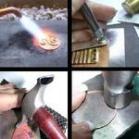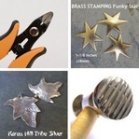a really black color
by Tracie
(Seattle)
I made a pendant of copper with silver balls. I'd like the copper to remain black. In the LOS it turned black really quickly. I let it sit for a while so the coverage is complete. Each time I touch it a bit of black comes off on my hand. I think adding a sealant would rub it off. It's as if the black is fine, caked on powder. What do you suggest use to keep a true black coating on the piece.
Thanks!
Stacy's Answer:
Hi Tracie!
First and foremost, make sure your metal is clean before attempting to add a patina. Polish and clean it before proceeding. Adding the patina is one of the last things I do. Basically, your piece should be finished and ready-to-go. Clean metal will oxidize more evenly.
It's important when using liver-of-sulfur (LOS) to patina copper that you use a really hot solution and if possible, also warm up the metal by dipping it first in hot water before placing it in the LOS. When you have the temperatures right, you'll get an almost immediate (3-5 seconds) black color to the copper and dark grey on the silver. You must then immediately remove the copper from the LOS or the LOS will continue to build up a velvety sludge on the surface of the copper which rubs off, usually revealing a splotchy copper color underneath and not evenly oxidized. I do get different patinas on copper by using different temperatures and strengths of the solution, along with the temperature of the metal, but for a really nice black, temperature and exposure is important.
Silver takes a bit longer to oxidize while the copper is really fast. Hot metal and a hot LOS solution will even this oxidizing time to nearly the same avoiding the sludgy copper and yellow, brassy looking silver.
You've got the temperatures and exposure to the LOS correct when first removed from the LOS, your copper appears almost like it's been enameled black. In other words, shiny and not velvety. Let the item dry and then tumble polish for about one hour. This will remove an excess LOS, but the pieces are still shiny and black in color. This patina does not come off on you! (the copper may still turn your skin green/black where it comes into contact with it, but the LOS is not coming off) You can use a polishing cloth to buff the copper to bring out brighter copper highlights or leave them black. Because copper oxidizes naturally at a very fast rate, you must add a lacquer or protective coating to the copper to insure that the copper does not continue to oxidize and ruin the black patina you've put on it.
A note of caution here.....most stones and glasses cannot withstand extreme temperature changes without suffering some damage. (hot to cold, etc.) So if the pieces of copper you're oxidizing also have some sort of stone beads/cabs or glass on them, heat them up slowly with increasingly hot water before submerging in a very hot LOS solution. Be sure to rinse with warm water too. Also, be sure to use the LOS in a well ventilated area so you are not breathing the fumes as they can be harmful.
Comments for a really black color
|
||
|
||
















